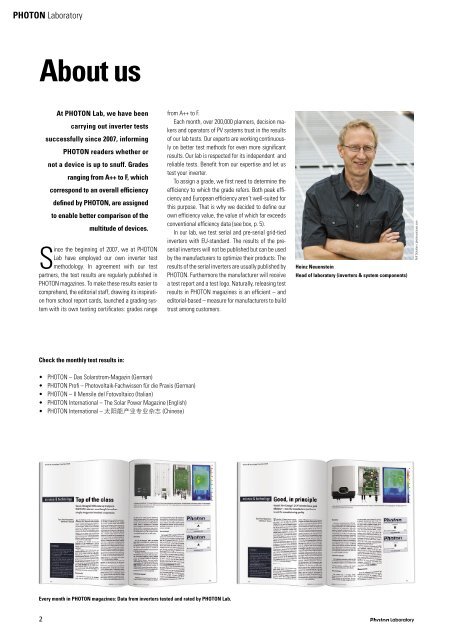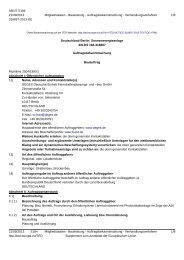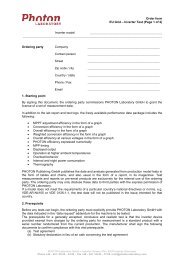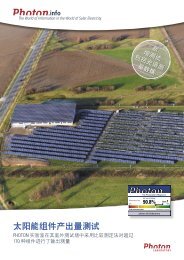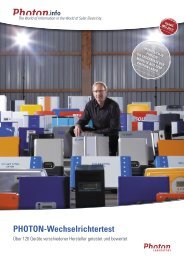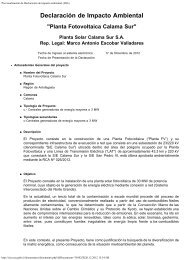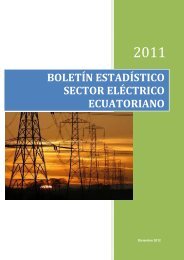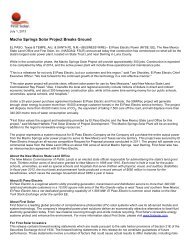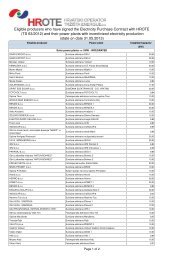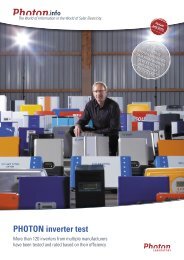PHOTON inverter test - PHOTON Info
PHOTON inverter test - PHOTON Info
PHOTON inverter test - PHOTON Info
- No tags were found...
You also want an ePaper? Increase the reach of your titles
YUMPU automatically turns print PDFs into web optimized ePapers that Google loves.
<strong>PHOTON</strong> LaboratoryAbout usAt <strong>PHOTON</strong> Lab, we have beencarrying out <strong>inverter</strong> <strong>test</strong>ssuccessfully since 2007, informing<strong>PHOTON</strong> readers whether ornot a device is up to snuff. Gradesranging from A++ to F, whichcorrespond to an overall efficiencydefined by <strong>PHOTON</strong>, are assignedto enable better comparison of themultitude of devices.Since the beginning of 2007, we at <strong>PHOTON</strong>Lab have employed our own <strong>inverter</strong> <strong>test</strong>methodology. In agreement with our <strong>test</strong>partners, the <strong>test</strong> results are regularly published in<strong>PHOTON</strong> magazines. To make these results easier tocomprehend, the editorial staff, drawing its inspirationfrom school report cards, launched a grading systemwith its own <strong>test</strong>ing certificates: grades rangefrom A++ to F.Each month, over 200,000 planners, decision makersand operators of PV systems trust in the resultsof our lab <strong>test</strong>s. Our experts are working continuouslyon better <strong>test</strong> methods for even more significantresults. Our lab is respected for its independent andreliable <strong>test</strong>s. Benefit from our expertise and let us<strong>test</strong> your <strong>inverter</strong>.To assign a grade, we first need to determine theefficiency to which the grade refers. Both peak efficiencyand European efficiency aren‘t well-suited forthis purpose. That is why we decided to define ourown efficiency value, the value of which far exceedsconventional efficiency data (see box, p. 5).In our lab, we <strong>test</strong> serial and pre-serial grid-tied<strong>inverter</strong>s with EU-standard. The results of the preserial<strong>inverter</strong>s will not be published but can be usedby the manufacturers to optimize their products. Theresults of the serial <strong>inverter</strong>s are usually published by<strong>PHOTON</strong>. Furthermore the manufacturer will receivea <strong>test</strong> report and a <strong>test</strong> logo. Naturally, releasing <strong>test</strong>results in <strong>PHOTON</strong> magazines is an efficient – andeditorial-based – measure for manufacturers to buildtrust among customers.Heinz NeuensteinHead of laboratory (<strong>inverter</strong>s & system components)Rolf Schulten / photon-pictures.comCheck the monthly <strong>test</strong> results in:• <strong>PHOTON</strong> – Das Solarstrom-Magazin (German)• <strong>PHOTON</strong> Profi – Photovoltaik-Fachwissen für die Praxis (German)• <strong>PHOTON</strong> – Il Mensile del Fotovoltaico (Italian)• <strong>PHOTON</strong> International – The Solar Power Magazine (English)• <strong>PHOTON</strong> International – (Chinese)Every month in <strong>PHOTON</strong> magazines: Data from <strong>inverter</strong>s <strong>test</strong>ed and rated by <strong>PHOTON</strong> Lab.2Laboratory


